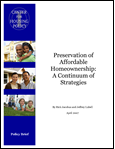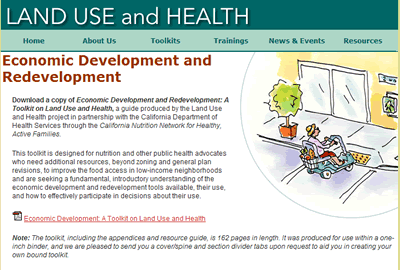« December 2006 | Main | May 2007 »
April 28, 2007
Economic Development for Public Health Advocates
This toolkit developed for the Public Health Institute's Land Use and Health Program is designed to provide an overview of Economic Development and Redevelopment issues for health advocates seeking new food stores in low income communities.
Download the full report or individual chapters at healthyplanning.org
TABLE OF CONTENTS:
Section I: Introduction to Economic Development, Redevelopment, and Health
1. Introduction to this Toolkit
2. The Connection Between Economic Development and Health
3. Why Do So Many Communities Lack Access to Healthy Food?
4. Developing a Strategy
Section II: Economic Development
5. What is Community Economic Development?
6. Types of Community Economic Development Programs
7. Economic Development Institutions
8. Financing Sources
Section III: Redevelopment
9. Overview of Redevelopment Law
10. Legal Requirements for Redevelopment
11. Introduction to Tax Increment Financing
12. Introduction to Eminent Domain
13. Support for Economic Development Projects
14. Final Points
Section IV: Strategies for Participation
15. Building Community Support
16. Data Collection
17. Model Redevelopment Resolution
18. Communicating with Public Officials
Section V: Appendices
Appendix 1: Sample Market Research Consultant Request for Proposals
Appendix 2: Redevelopment Agency Model Resolution
Appendix 3: Resources
Posted by Rick Jacobus at 05:01 PM | Comments (0)
Preservation of Affordable Homeownership
 |
Download Preservation of Affordable Homeownership: A Continuum of Strategies
Written by Rick Jacobus and Jeff Lubel. Published by the Center for Housing Policy of the National Housing Conference. |
In recognition of the significant benefits of homeownership for families and the communities in which they live, many cities, counties and states have adopted policies that seek to increase residents’ access to affordable homeownership opportunities. This paper examines the range of different policy options that communities have adopted to reduce the cost of homeownership, with a particular focus on the effectiveness of each option in preserving affordable homeownership opportunities over time.
The focus of this review on the preservation of affordable homeownership grows out of the collective experience of numerous communities around the country with sharply rising home prices over the past five to ten years. As many communities have learned the hard way, homes that they helped make affordable through an initial downpayment grant or other assistance often have become unaffordable when sold to the next family. With the amount of subsidy needed to bring homeownership within reach of working families growing exponentially, communities have struggled with the question of how to ensure that the public’s investments in homeownership keep pace with the market. This review provides an overview of the range of mechanisms that local governments use to ensure that housing funds invested in affordable homeownership today are able to serve additional families into the future. In general, this is accomplished either through resale restrictions that preserve the affordability of specific assisted units or through deferred loans that allow the locality to capture a portion of home price appreciation at the time that assisted units are sold that can then be used to help subsequent buyers purchase homes of their choice.
Posted by Rick Jacobus at 04:45 PM | Comments (0)
Shared Equity, Transformative Wealth
 |
Download Shared Equity, Transformative Wealth
Written by Rick Jacobus. Published by the Center for Housing Policy of the National Housing Conference. |
After nearly a decade of rapid increases, home prices have finally stabilized in most parts of the country; in some areas, they have even started to decline. The current pause in the housing market provides an historic opportunity for communities to review their homeownership programs and ensure they are well-designed to address the inevitable resumption of home price appreciation in the near future. This paper provides an analysis of several alternative strategies for sharing the equity growth that accompanies home price appreciation to balance the dual goals of individual asset accumulation and ongoing affordability to future home purchasers.
As home prices have risen over the past decade, many local government homeownership programs have been forced to dramatically increase the level of public subsidy available to each family – some are now providing well over $100,000 per family. As subsidy levels have risen, more and more jurisdictions have turned to shared equity approaches that split the equity that results from home price appreciation. Under these approaches, a portion of the equity growth goes to the homeowner – augmenting the asset growth they achieve through paydown of principal on their mortgage – and a portion either stays attached to the home to ensure its ongoing affordability or goes back to the local government to be used to help subsequent purchasers afford to buy a home.
Despite their great benefits, shared equity approaches are sometimes criticized from an asset-building perspective because they prevent homeowners from realizing the full wealth-creation benefits associated with traditional homeownership. In The Hidden Cost of Being African American, Thomas Shapiro uses the term “Transformative Assets” to refer to assets like homeownership that transform people’s lives and lead to better lives for their children. It is clear that traditional homeownership can have this kind of impact – at least in a stable or rising housing market – but what about shared equity homeownership? Given all the controversy over shared equity homeownership, it seems worth asking: how do shared equity homeownership programs perform as asset-building mechanisms? How do the returns available in these programs compare with market-rate ownership? Do some shared equity approaches do a better job of generating meaningful wealth while still preserving affordability? Is the equity that shared equity homeowners earn enough to change people’s lives?
Posted by Rick Jacobus at 04:08 PM | Comments (0)
April 25, 2007
Vallejo Inclusionary Housing Program Design Workshop
This workshop conducted on behalf of the City of Vallejo, CA for community stakeholders and policymakers provided a quick overview of some of the program design issues related to preservation of affordability in inclusionary homeownership units.
Interactive Resale Formula Comparision Tool
Handouts:
Agenda
Common goals for resale pricing formulas
Powerpoint: Administering Inclusionary Homeownership Programs
Additional Resources:
Understanding Subsidy Retention: A Flash Animation
Introduction to Community Land Trusts
Starting a CLT: Organizational and Operational Choices
Posted by Rick Jacobus at 10:23 AM | Comments (0)


